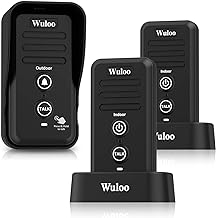5 important factors worth considering when looking for the best doorbell for hearing impaired with flashing light
When choosing a doorbell for people who are deaf or hard of hearing, it’s important to consider a few important things to make sure it’s safe and convenient. There are many options available, so you should think about how bright and visible the flashing light is, how far the signal reaches, if it works with your current doorbell system, and how easy it is to install and use. By thinking about these things carefully, you can choose a doorbell that helps people with hearing impairments feel more independent and included. It’s important to focus on making products that are accessible and useful for everyone.
See our guide to the best doorbell for hearing impaired with flashing light.
Brightness and visibility of the flashing light
When you’re buying a doorbell for someone with hearing loss, how bright and visible the flashing light is really matters. The light signals when someone’s at the door, even if they can’t hear the bell. A strong, easy-to-see light doesn’t just help people who are hard of hearing – it also makes the doorbell system work better. It’s like a guide, helping those who depend on visual cues feel more secure and confident navigating their surroundings.
In the world of assistive technology, the flashing light on a doorbell for the hearing impaired is super important. It can be the difference between missing a package and greeting a visitor, feeling unsure or at ease. A well-designed flashing light provides a sense of safety and belonging, offering accessibility that goes beyond just being convenient. That’s why, when choosing a doorbell for people with hearing impairments, making sure the flashing light is bright and easy to see isn’t just an option – it’s necessary for creating a more connected and inclusive home environment.
Ability to adjust the volume and tone of the alert sound
When buying a doorbell designed for the hearing impaired, it’s important to be able to adjust the volume and tone of the alert sounds. This isn’t just a fancy feature, it’s a necessity. While flashing lights grab attention visually, being able to adjust the sound amplification is also key. Everyone’s hearing is different, so having the option to customize the volume and tone ensures that no one misses important alerts at home. This feature shows that the designers are thinking about the diverse needs of users and want to help them feel safe and independent in their homes.
Being able to personalize the sound settings on a doorbell for the hearing impaired is really important. It goes beyond just being convenient and shows that our goal is to have a more inclusive society. Allowing people to choose how they want to be alerted isn’t just about selling a product, it’s about showing respect and making sure everyone’s needs are considered. In a world where people with hearing impairments are often forgotten, this kind of customization shows a more thoughtful and fair way to use technology. It’s a small step, but it’s a big deal in making sure everyone, no matter their abilities, can feel confident and respected as they move through their surroundings.
Range of wireless connectivity for the receiver
When buying a doorbell with a flashing light for people who are deaf or hard of hearing, it’s important to think about how far away the receiver can be from the transmitter. The effectiveness of the doorbell depends on the receiver being able to pick up signals from the transmitter, no matter where it is in the house. Choosing a doorbell with a long wireless range ensures that the flashing light will go off quickly, making it safer and more convenient for people with hearing impairments.
Having a doorbell with a wide wireless range not only helps practically, but it also gives peace of mind by making sure the doorbell works well throughout the whole house. Whether you’re cooking in the kitchen or relaxing in your bedroom, a doorbell with a good wireless range means you won’t miss any visitors. By focusing on a doorbell with a large coverage area and flashing light, you’re investing in accessibility and independence, which are really important for people with hearing impairments who want to feel confident and independent in their daily lives.
Durability and weather resistance of the doorbell
When you’re buying a doorbell for someone who has trouble hearing, it’s important to think about how long it will last and if it can handle all kinds of weather. It’s crucial for a doorbell to work well, especially for people who need to see bright lights to know when someone is at the door. A strong doorbell will last a long time and keep working well, giving peace of mind to people who need it for important alerts. And it’s equally important for a doorbell to be able to handle different weather conditions so it can keep working properly over time. A doorbell that can stand up to the weather will keep working consistently, making it a reliable tool for people with hearing impairments.
Choosing a doorbell that is both strong and able to handle different weather conditions is not just about convenience – it’s necessary for those who need to see visual alerts. By focusing on these features, users can trust that their doorbell will keep working without needing to be replaced often or breaking because of the weather. Ultimately, picking a doorbell that promises durability and resistance to weather is a smart move to meet the unique needs of people with hearing impairments. It gives them a reliable and effective way to communicate through visual alerts.
Compatibility with other assistive devices or systems
When you’re thinking about buying a doorbell for someone who is hard of hearing that flashes a light, it’s important to make sure it works well with other assistive devices or systems. Having it connect smoothly with other technologies can make life easier and more efficient. By choosing a doorbell that can easily work with alarm systems, smartphones, or smart home hubs, users can create a network of accessibility solutions that work together to improve their quality of life.
A doorbell for the hearing impaired that can communicate well with other assistive devices not only makes things easier for the user but also helps them feel more empowered and independent. Being able to integrate different devices allows individuals to set up alerts the way they want, create personalized notifications, and expand the capabilities of their assistive technology. This collaboration between devices creates a supportive environment that meets the individual’s needs and opens up possibilities for improving accessibility and connectivity at home and in other settings.
Conclusion
In a world where everyone should feel included, having doorbells that flash for people who are deaf or hard of hearing is important. This helps create a more welcoming environment for everyone. By using these new technologies, we can improve communication and build a more caring society. Just putting up a doorbell with a flashing light can make a big difference for people who can’t hear well, giving them more freedom and security. These small changes not only help individuals but also change the way we think about including everyone in our neighborhoods.


